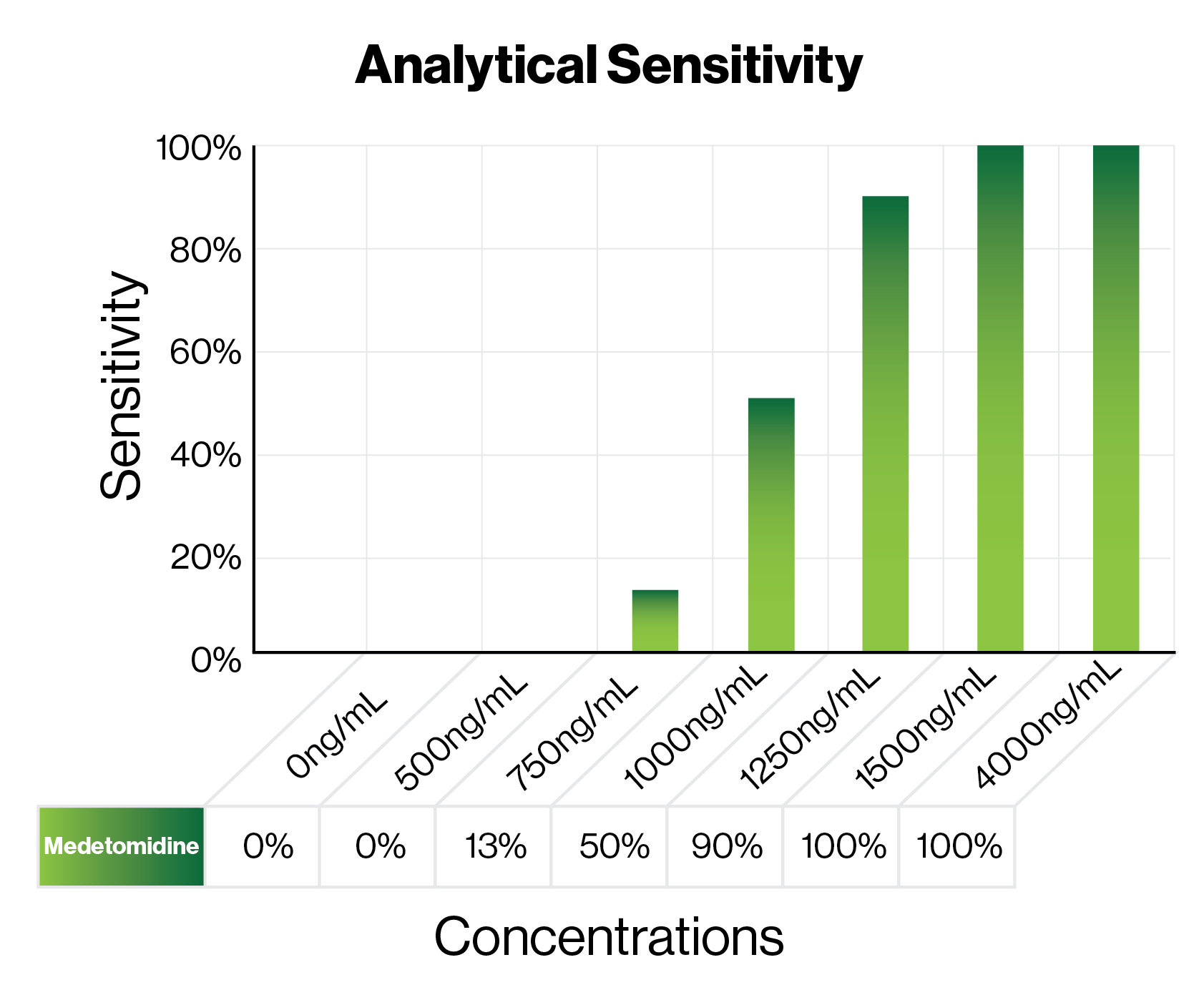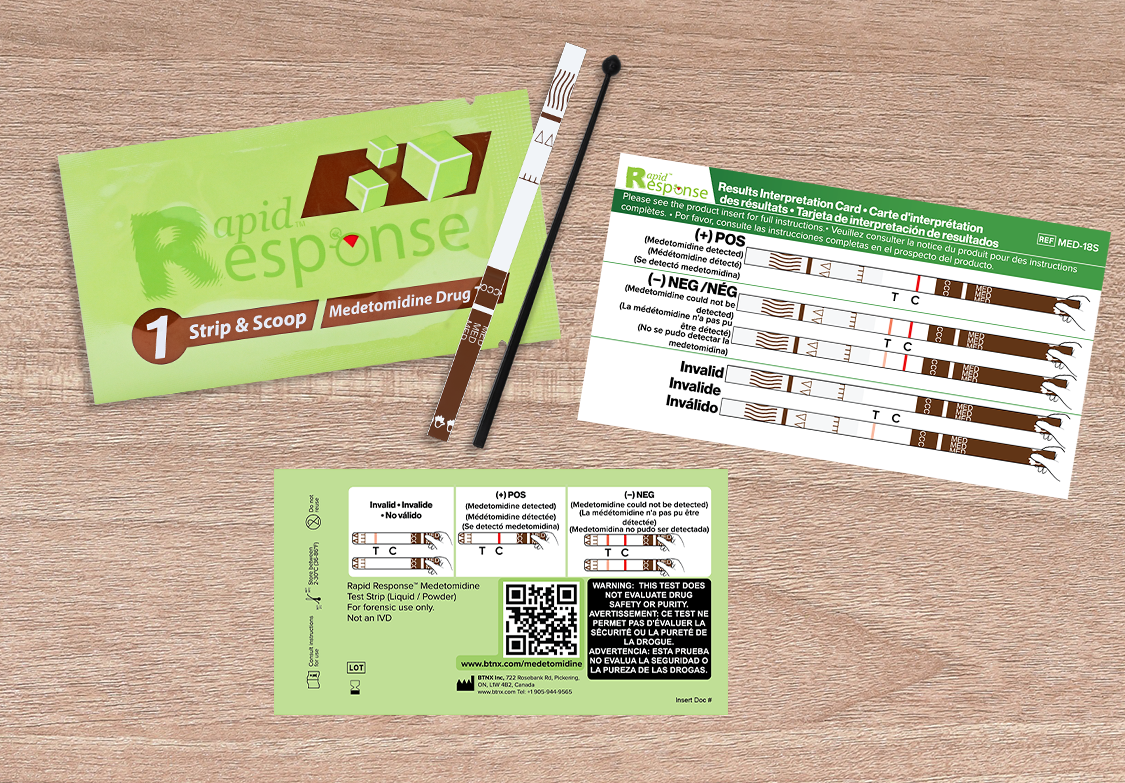|
Highlights:
|
Medetomidine has been identified as an emerging new compound in the drug supply, found in samples combined with fentanyl, quinine, and xylazine. Medetomidine is a potent sedative and analgetic drug primarily used in veterinary medicine. It belongs to the class of α-2 adrenergic agonists, similar to xylazine. Medetomidine is primarily used in animals for procedures that require mild to moderate sedation, pre-anesthesia, or for managing pain. Medetomidine can cause side effects like bradycardia (slow heart rate) and hypotension (low blood pressure) and can be potentially deadly if combined with other substances.
Medetomidine was first identified in the state of Maryland in July 2022 from suspected drug packaging and is increasingly found in the drug supply across the United States and Canada. Medetomidine has been associated with overdoses in April and May 2024 in Philadelphia, Pittsburg, and Chicago.2, 3
Public health and safety and forensic science personnel continue to face the emergence of new illicit substances in the drug market. The need to continuously monitor and detect new compounds, that may lead to misuses and overdose, became relevant since the introduction of xylazine, a veterinary sedative, into the fentanyl and heroin drug supply.1 Co-mixtures of synthetic opioids with other central nervous system depressants, including animal tranquilizers has complicated the fentanyl overdose situation, making reversal more difficult.2
Veterinary Medicine
Medetomidine is another α-2 adrenergic agonists and belongs to the same drug class as the adulterant xylazine, a veterinary tranquilizer. This synthetic drug is routinely used in veterinary medicine as a sedative usually administered to small animals and is often combined with opioids, ketamine, and benzodiazepines when administered.2
Medetomidine is a sedative, anxiolytic, muscle relaxant, and analgesic drug that is intended for veterinary use in small animals, including dogs and cats, in the United States, Canada, and Europe. It is the most potent α-2 adrenoreceptor available for clinical use in veterinary medicine with a longer duration of sedation and analgesia compared to xylazine.4, 5
Medetomidine is a racemic mixture of two optical isomers: Dexmedetomidine, an FDA approved drug for human administration commonly used in hospital settings6, and Levomedetomidine, both are commonly used in veterinary medicine as a sedative and analgesic.7, 8 Medetomidine is not approved for human use.9 The Federal Drug Administration (FDA) approved the use of dexmedetomidine as a sedative-analgesic anesthetic for adult and pediatric patients. Dexmedetomidine has a therapeutic role for patients, under monitored anesthesia care, with opioid/benzodiazepine withdrawal. It also has potential for treatment of agitation and alcohol withdrawal.6
Like other alpha-2 agonists, Medetomidine is a reliable veterinary drug for sedation, analgesia, muscle relaxation, and anxiolysis. However, negative side effects include cardiovascular, respiratory, gastrointestinal, and hypothermia. The main negative cardiovascular effects include bradycardia, associated arrhythmias, hypertension, hypotension, and an increase in systemic vascular resistance (SVR).9
Test strips can aid in harm reduction and overdose prevention. The Rapid Response® Medetomidine Test Strip is a rapid test for the detection of medetomidine in liquid or powder substances. This test can detect other related compounds including dexmedetomidine. It is for forensic use only and is not an IVD.
Analytical Sensitivity
The sensitivity of the Rapid Response® Medetomidine Test Strip (Liquid / Powder) was determined by tested GC/MS confirmed controls to the concentration at negative, -75%, -50% cutoff, -25% cutoff, cutoff, +25% cutoff, +50% cutoff and 3 times of cutoff. The results are summarized below:
| Drug Conc. (Cut-off Range) | n | MED | |
| - | + | ||
| 0% Cut-off | 30 | 30 | 0 |
| -50% Cut-off | 30 | 30 | 0 |
| -25% Cut-off | 30 | 26 | 4 |
| Cut-off | 30 | 15 | 15 |
| +25% Cut-off | 30 | 3 | 27 |
| +50% Cut-off | 30 | 0 | 30 |
| +300% Cut-off | 30 | 0 | 30 |

Analytical Specificity
The following compounds were spiked into water, respectively, to examine the ability of the Rapid Response® Medetomidine Test Strip for detecting medetomidine and medetomidine-related analogues. The concentration listed in the table represents the substance concentration at which the test strip will begin to show a mix of positive and negative results.
| Medetomidine 1000 related compounds | |
| Compound | Concentration (ng/mL) |
| Medetomidine | 1000 (100%) |
Principle of Medetomidine Test Strip
The Rapid Response® Medetomidine test strip can be used for drug checking purposes but provides only qualitative, presumptive results of the presence of medetomidine in drug samples. The test sample migrates upward by capillary action across the strip and if medetomidine is not or is present below the cut-off level, a colored line will form in the test line region. If medetomidine is present or is above the cut-off level, the colored line will not form in the test line region. A colored line will always appear at the control line region as a procedural control, indicating proper specimen volume and test procedure.
Packaging
Each test kit comes with individually sealed test strips in pouches for easy distribution and transportation. Our test strips also come with microscoops for a more convenient and accurate testing process. A result interpretation card is also included as a guide for reading the results where users can align and match the test strip with the illustration on the card. QR codes to external resources are printed on every packaging for a user-friendly experience.

The Rapid Response® Medetomidine Test Strip (Liquid / Powder) is available to purchase under the product code MED-18S2-100 from Lochness Medical Supplies in the USA and BTNX Inc. in Canada and the international market.
- Sisco, Edward, and Meghan Appley. “Identification of the veterinary sedative medetomidine in combination with opioids and xylazine in Maryland.” Journal of forensic sciences vol. 68,5 (2023): 1708-1712. doi:10.1111/1556-4029.15242.
- Palamar JJ, Krotulski AJ. Medetomidine Infiltrates the US Illicit Opioid Market. JAMA. Published online September 04, 2024. doi:10.1001/jama.2024.15992
- Schwarz ES, Buchanan J, Aldy K, et al. Notes from the Field: Detection of Medetomidine Among Patients Evaluated in Emergency Departments for Suspected Opioid Overdoses — Missouri, Colorado, and Pennsylvania, September 2020–December 2023. MMWR Morb Mortal Wkly Rep 2024;73:672–674. DOI: http://dx.doi.org/10.15585/mmwr.mm7330a3.
- Sinclair, Melissa D. “A review of the physiological effects of alpha2-agonists related to the clinical use of medetomidine in small animal practice.” The Canadian veterinary journal = La revue veterinaire canadienne vol. 44,11 (2003): 885-97.
- Vainio, O. “Introduction to the clinical pharmacology of medetomidine.” Acta veterinaria Scandinavica. Supplementum vol. 85 (1989): 85-8.
- Grewal, Anju. Dexmedetomidine: New avenues. Journal of Anaesthesiology Clinical Pharmacology 27(3):p 297-302, Jul–Sep 2011. | DOI: 10.4103/0970-9185.83670
- Kuusela, E et al. “Sedative, analgesic, and cardiovascular effects of levomedetomidine alone and in combination with dexmedetomidine in dogs.” American journal of veterinary research vol. 62,4 (2001): 616-21. doi:10.2460/ajvr.2001.62.616
- Schwarz ES, Buchanan J, Aldy K, et al. Notes from the Field: Detection of Medetomidine Among Patients Evaluated in Emergency Departments for Suspected Opioid Overdoses — Missouri, Colorado, and Pennsylvania, September 2020–December 2023. MMWR Morb Mortal Wkly Rep 2024;73:672–674. DOI: http://dx.doi.org/10.15585/mmwr.mm7330a3.
- Kumar Rajesh, Singh M., Verma N.K., Akash, R. Sasikala, Kumar R., Hoque M. (2020). Systemic Effects and Clinical Application of Medetomidine in Animals: A Review. Indian Journal of Animal Research. 54(9): 1063-1068. doi: 10.18805/ijar.B-3864.

 Canada
Canada